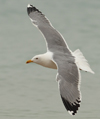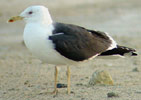 Heuglin's Gull (L. heuglini / antelius)
Heuglin's Gull (L. heuglini / antelius)
(last update:
Amir Ben Dov (Israel)
Chris Gibbins (Scotland)
Hannu Koskinen (Finland)
Mars Muusse (the Netherlands)
adult heuglini: February
General description of adult heuglini in February-March in Bahrain
In Bahrain, heuglini was more or less easily identified in mixed group of gulls, as soon as adult-like feathers appear. In the homogeneous grey-tone of adult barabensis, a dark gull attracts attention and must be either fuscus or heuglini in this region. Fuscus is even darker, almost black.
In the Arabian Gulf, four species of large gulls can be found commonly. Heuglini, and fuscus are breeding species from the northern tundra. Cachinnans and barabensis are steppe breeders. The breeding location may provide criteria for identification of single individuals. Breeding on either southern steppe or northern tundra has some major consequences:
a: the breeding season starts much earlier on the steppe, hence can be finished much earlier. Therefore adults from the steppe belt can take on their migration earlier in the season.
b: northern breeders must migrate over much longer distances and this has consequences for their moult strategy and timing. The late moult timing of the primaries in both heuglini and fuscus is obvious and often interrupted (arrested) during migration. In the Arabian Gulf, by January P8 - P10 can still be growing as is shown by some images of A & M Ujihara in the January section. Also, the visible central primaries and the tips of these feathers look brand new in January, as they are recently moulted, contra e.g. cachinnans, which has the moult completed for over a month.
c: steppe breeders spend much more time under tropical climate conditions, while feathers of the tundra breeders are less likely to be exposed to such conditions for prolonged periods, and this may have effects on bleaching and wear of e.g. primaries.
Ageing adult heuglini in winter plumage
In mid-winter, heuglini normally can be found along shores & on beaches, fish-markets and rubbish dumps in E Africa, the Middle East and further east to the coastline of Bombay. They often flock together with other species in winter. Heuglini, being a north Russian tundra breeder, can normally identified by the late moult process in winter. They often have the last stage of primary moult on the wintering grounds, with outer primaries still growing in January and February (and they share this late moult with nominate fuscus, the other tundra species). Primary moult in steppe species (michahellis, armenicus, cachinnans, barabensis) should be finished by December, and the primary tips can already show some wear in the tips by mid-winter.
The two tundra species fuscus and heuglini can normally safely identified on upper-part grey tone alone, which is blackish in fuscus and slate grey in heuglini.
Adult heuglini in winter show a plumage much similar to adult birds in summer, with a few subbtle differences:
- head streaking obvious in mid-winter, most concentrated on the hind-neck.
- bare parts not saturated but yellow parts often straw yellow, sometimes a bit flesh-coloured (base of bill, legs).
- black markings on bill more prominent, sometimes a complete bill-band in winter.
Ageing adult birds from sub-adults can be difficult in heuglini. Identification is complicated due to two effects:
a. some immature birds may have gone through a rapid moult strategy, looking more mature at early ages, when compared to well-known taxa of Lesser Black-backed Gull and Herring Gull. Such advanced birds in 2cy spring may continue to be ahead in plumage development throughout their immature years (we don't know yet, we have no time-series of observations on ringed birds).
b. full adult birds may still show features associated with sub-adult plumage, like bill-band and black on the greater primary coverts.
A variable number of immature features may still be possible, but best clue to age adults is the absence of broad dark centres of the greater primary coverts. Small, sharply defined centres on slate grey feathers probably is possible in full adults as well, but when the centres are broad brownish-black and the tips of these greater primary coverts are pale whitish, this may be good indication for sub-adult birds. Furthermore, black may still be apparent in the rectrices, some brown wash may be vsible on some wing-coverts and the bill-band may be obviously broad in 3cy and 4cy winter birds.
 Heuglini adult, February 06 2008, Morjim Beach, Goa, India. Picture: Tom Tams. P9 fully grown.
Heuglini adult, February 06 2008, Morjim Beach, Goa, India. Picture: Tom Tams. P9 fully grown. Heuglini adult, February 02-09 2009, United Arab Emirates. Picture: Chris Gibbins.
Heuglini adult, February 02-09 2009, United Arab Emirates. Picture: Chris Gibbins. Heuglini adult, February 02-09 2009, United Arab Emirates. Picture: Chris Gibbins.
Heuglini adult, February 02-09 2009, United Arab Emirates. Picture: Chris Gibbins. Heuglini
adult, February 04 2011, Ashdod, Israel. Picture: Amir Ben Dov.
Heuglini
adult, February 04 2011, Ashdod, Israel. Picture: Amir Ben Dov.  Heuglini
adult, February 26 2011, Ashdod, Israel. Picture: Amir Ben Dov.
Heuglini
adult, February 26 2011, Ashdod, Israel. Picture: Amir Ben Dov.  Heuglini
adult, February 26 2011, Ashdod, Israel. Picture: Amir Ben Dov.
Heuglini
adult, February 26 2011, Ashdod, Israel. Picture: Amir Ben Dov.  Heuglini adult, February 06 2008, Morjim Beach, Goa, India. Picture: Tom Tams.
Heuglini adult, February 06 2008, Morjim Beach, Goa, India. Picture: Tom Tams.  Heuglini adult, February 06 2008, Morjim Beach, Goa, India. Picture: Tom Tams. P8 fully grown.
Heuglini adult, February 06 2008, Morjim Beach, Goa, India. Picture: Tom Tams. P8 fully grown. Heuglini adult, February 06 2008, Morjim Beach, Goa, India. Picture: Tom Tams. Pale upperparts may point to barabensis.
Heuglini adult, February 06 2008, Morjim Beach, Goa, India. Picture: Tom Tams. Pale upperparts may point to barabensis.  Heuglini adult, February 02-09 2009, United Arab Emirates. Picture: Chris Gibbins.
Heuglini adult, February 02-09 2009, United Arab Emirates. Picture: Chris Gibbins. Heuglini adult, February 02-09 2009, United Arab Emirates. Picture: Chris Gibbins.
Heuglini adult, February 02-09 2009, United Arab Emirates. Picture: Chris Gibbins. Heuglini
adult, February 19 2011, Ashdod, Israel. Picture: Amir Ben Dov.
Heuglini
adult, February 19 2011, Ashdod, Israel. Picture: Amir Ben Dov.  Heuglini
adult, February 19 2011, Ashdod, Israel. Picture: Amir Ben Dov.
Heuglini
adult, February 19 2011, Ashdod, Israel. Picture: Amir Ben Dov.  Heuglini
adult, February 19 2011, Ashdod, Israel. Picture: Amir Ben Dov.
Heuglini
adult, February 19 2011, Ashdod, Israel. Picture: Amir Ben Dov.  Heuglini adult, February 26 2001, Bahrain: Muharraq Jetty. Seems a bit dark in early morning light.
Heuglini adult, February 26 2001, Bahrain: Muharraq Jetty. Seems a bit dark in early morning light.